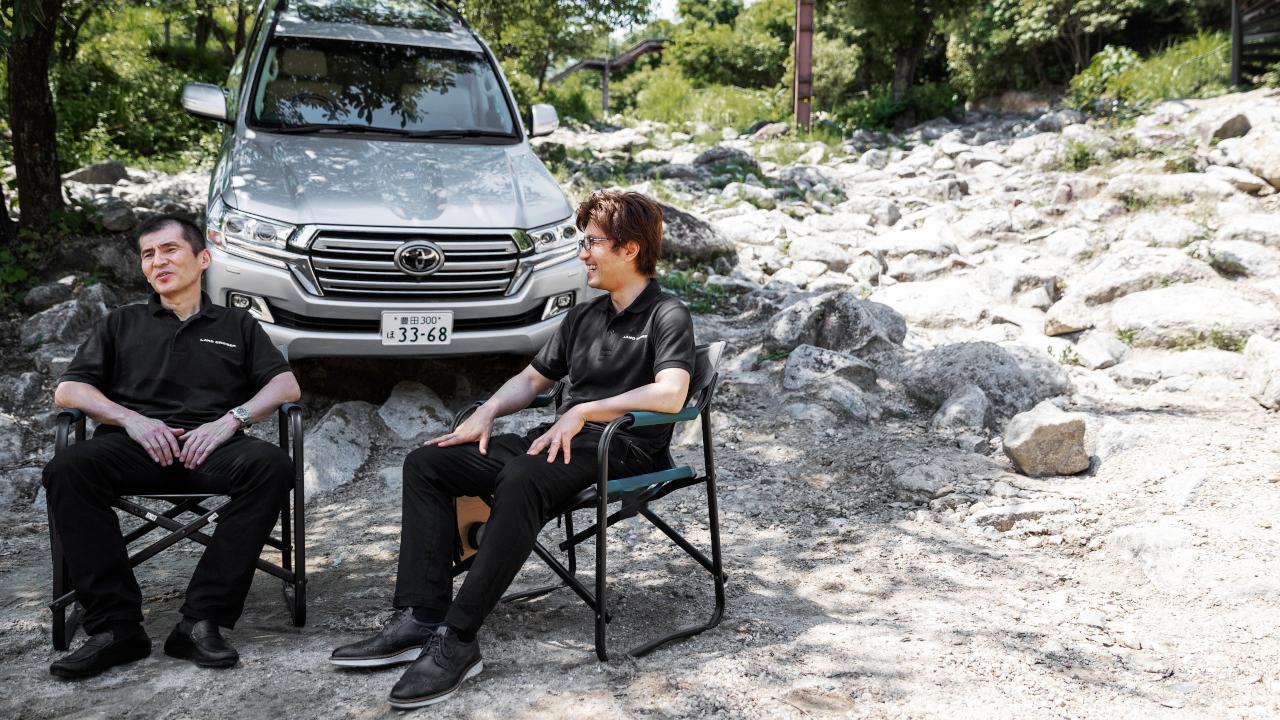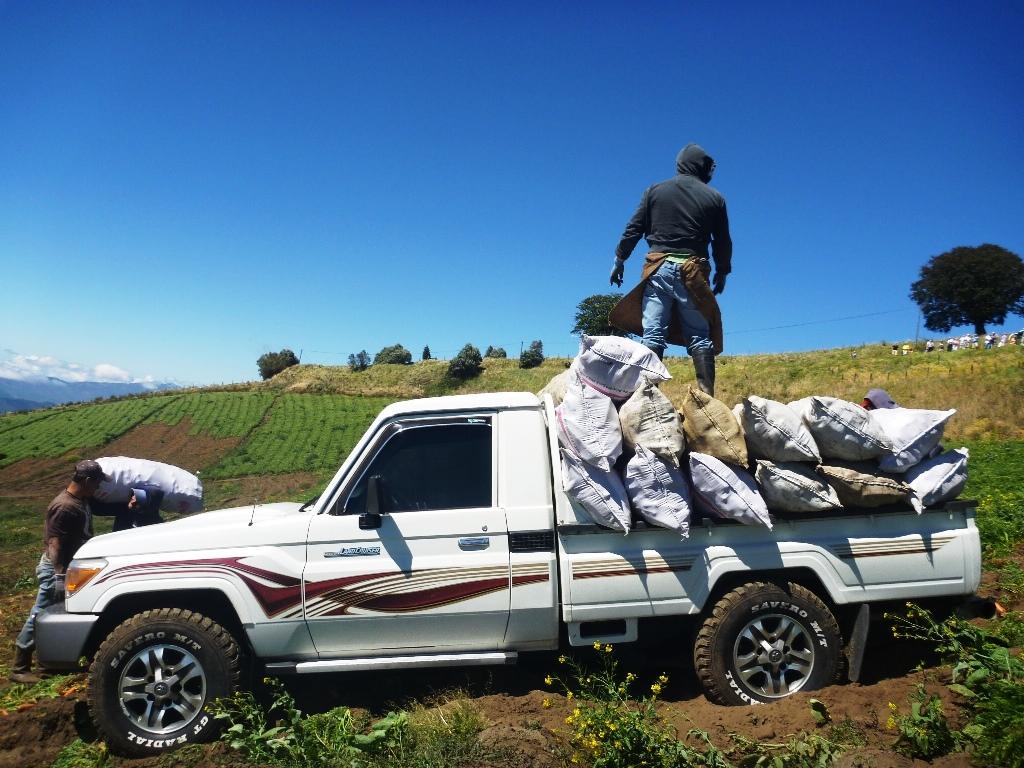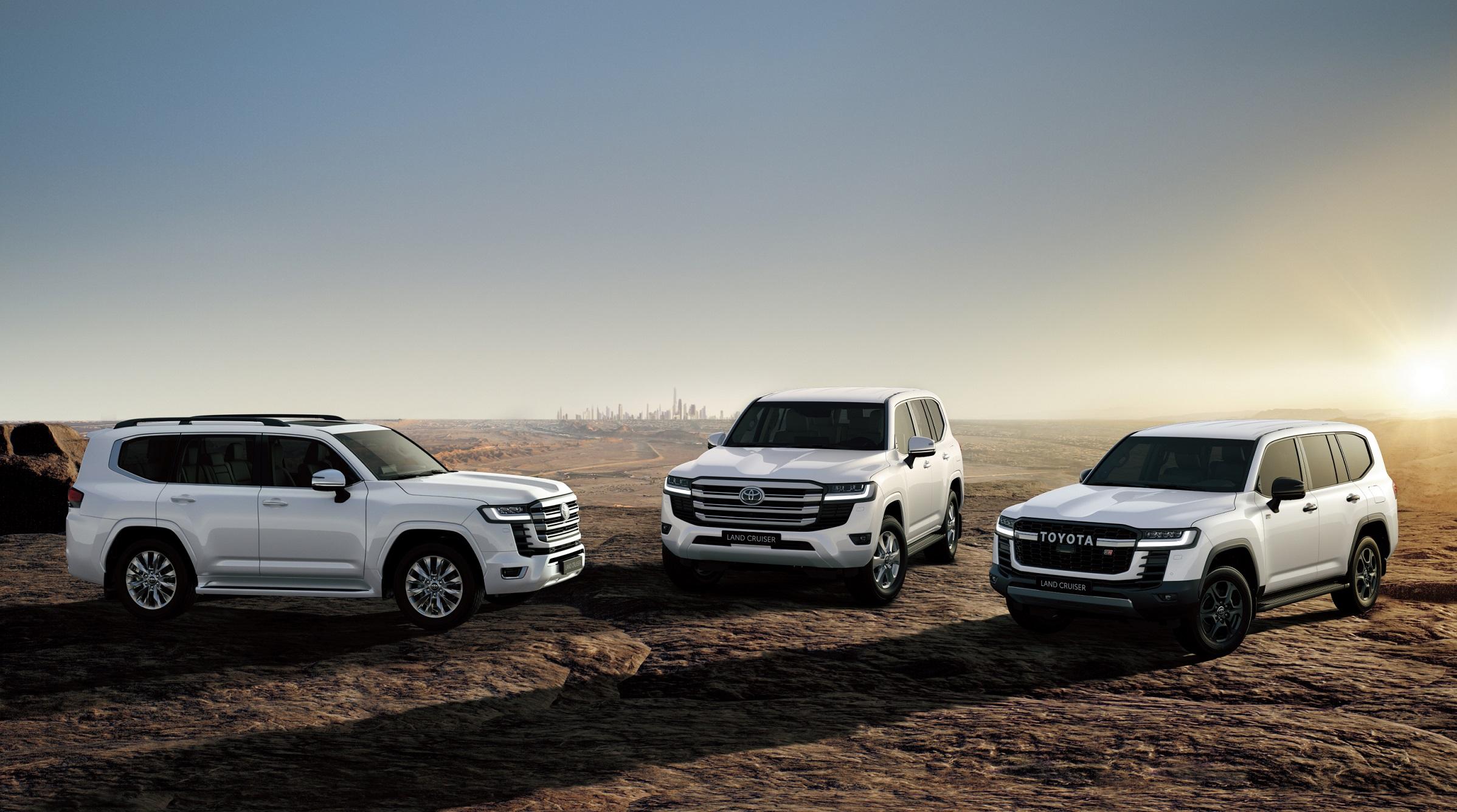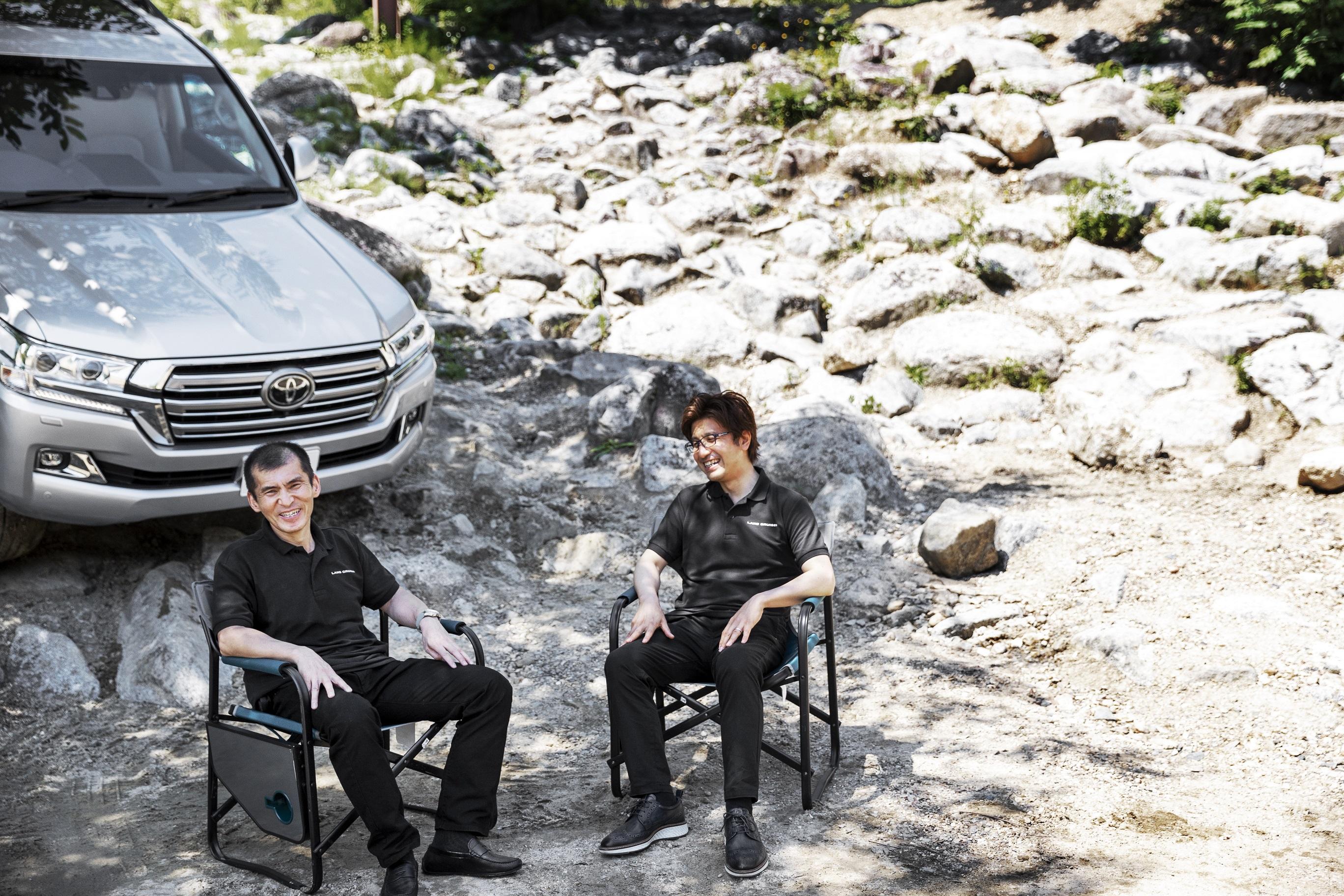
The all-new Land Cruiser, the latest 300 Series made its debut in June 2021, as the year marks the model's 70th anniversary. Two engineers who lead the Land Cruiser development talk about what it has been true to in its long history, representing Toyota's three strengths in quality, durability, and reliability.

Genchi genbutsu leads to real vehicle evaluation
In Part 1, the current 70 Series and Prado chief engineer Sadayoshi Koyari spoke of how, 70 years ago, the first-generation BJ Series and its developers had already established the essence of today’s Land Cruiser: reliability, durability, and drivability on rough terrain. Inheriting the Land Cruiser’s car-making philosophy from Koyari, Takami Yokoo, chief engineer for the latest-generation 300 Series, added the following comments.
Yokoo
This may sound exaggerated, but when I think of the Land Cruiser today, I see it as a car that sustains the lives and livelihoods of people all over the world, from Africa, the Middle East, Australia and other markets to the polar regions.
What’s required of the Land Cruiser is a car that can go anywhere & everywhere and come back alive and safe. We’ve tried to make the 300 Series the best car that it can be. Technological and environmental changes may redefine the optimal solution, as the needs of our customers and the earth continue to evolve.

Yokoo
Genchi genbutsu means visiting the harsh environments where Land Cruisers are used, seeing them for yourself, and learning what it is like to be in these desperate situations where people’s lives are at stake. From that starting point, I think the next development keyword is “real vehicle evaluation”.
Today, simulation technology has progressed and, with improved analytical capabilities, found its way into all aspects of automotive development. If you needed to, you could create a car with that alone, to an extent.
To develop the Land Cruiser, however, we have vehicle evaluation specialists drive the actual cars to find and fix anything that breaks, in a way that would not be possible through simulation. Most importantly, we need to check what conditions cause things to break.
Of course, meeting numerical goals and internal standards is important, but Koyari emphasizes, and Yokoo agrees, that simply clearing these targets does not ensure safety – a Land Cruiser must go further if it is to be entrusted with customers’ lives.
In fact, Land Cruisers have completed a total of over one million kilometers (a result rather than a target) in durability testing as part of development, a distance equal to more than 25 journeys around the globe.
“Breakdown testing” helps each model surpass the last
No car is 100 percent – perhaps more like 60 depending on how you use it. Especially for a car going into extreme conditions, we can’t simply say, ‘this is good enough’, and we must continue to be cautious about things beyond our control,” emphasizes Koyari.
That is why development involves thorough testing until the breaking point, and why engineers each time seek to “match or surpass previous models” in every respect. Having been engaged in this process very recently, Yokoo describes it as follows.
Yokoo
In developing a new model, we must meet various targets, and of course consider cost in all areas. Whenever we have to weigh up trade-offs, such as eliminating one thing to go over cost on another, for the Land Cruiser the non-negotiable aspects that must be maintained are very clear.
If you only drive the car on well-paved roads in developed countries, the quality will be excessive in some areas. It’s not difficult to set numerical targets for reliability. But if from the outset you need to match or surpass the previous model, it instantly raises the difficulty.
For example, if the 300 Series struggles with environments that didn’t pose trouble for the existing 200, this is not only a drop in performance but potentially life-threatening for the customer. That’s why we have a lot to do, or rather, a lot to break. Our mission with the Land Cruiser is to continue evolving by overcoming each one of these challenges.
One of the ways the development team does this is through the various forms of “breakdown testing”.
For example, one test designed to find strength limits involves repeatedly putting the car under stresses that would be unthinkable in regular acceleration tests for durability. This is done by slamming the vehicle against the ground with a force that would throw a human driver from their seat (testing is conducted with autonomous driving).
These tests are not intended for passing given standards; rather, the development philosophy is to check how far the car can be pushed before breaking down, enabling the team to send it out into the world with confidence. This approach can be considered the foundation of the Land Cruiser’s, and hence Toyota’s, unique QDR (Quality, Durability, Reliability).
Nonetheless, even a car that rolls off the production line with 100 percent reliability will be subject to the whim of its owner, and at times driven in over-harsh conditions. Despite this, the development team needs to ensure that improvement is ongoing, as Koyari explains.
Koyari
Trust is the ultimate result you can obtain from customers in the market. The 40 Series has been manufactured and used for 24 years, the 70 Series for 37. This is something I’m conscious of because I've experienced the Land Cruiser’s 50th and 60th anniversaries, but how did earlier generations of engineers develop the car?
In terms of repairability and spare parts, if you dig around you'll find a surprising number of parts shared among each series, such as the 20-40-55 series and the 40-60-70 series. To put it another way, as model cycles for each generation become longer and the cars spread around the world, repairability improves.
For example, parts from an old wreck in the back of a demolition shop can be used to get another car back on the road. All of these elements help to boost reliability.
Unwavering commitment to ensure Cruisers “come back alive”
At the same time, today’s drivers seek increasingly diverse values from a genuine cross-country 4WD. Although surviving harsh conditions remains a key prerequisite, in developed countries the cars should also be suited to everyday driving on urban roads or highways, while still offering drivers comfort and peace of mind in desert areas or rough terrain. What was Yokoo’s approach for dealing with this reality?
Yokoo
Above all, the key is designing a Land Cruiser that can sustain the basic functions – driving, turning, stopping – for as long as possible. In an extreme case, you could manage to come back alive even without bumpers, body panels, or a roof.
That’s why, even though monocoque structures that integrate chassis and body are now common in SUVs, for the new 300 Series we stuck to the body-on-frame arrangement, where the cabin is installed on a ladder frame using rubber mounts, which allows us to create a stronger chassis.
The newest feature of the 300 Series is the use of an entirely new platform based on the TNGA (Toyota New Global Architecture) design concept, part of Toyota’s comprehensive efforts to make ever-better cars.

The major change for this 300 Series is how it feels to drive. I often describe it as ‘stress-free’. The Station Wagon-type Land Cruisers are certainly not small, but we have made this one even lighter than the 200 Series, with a lower center of gravity.
By doing so we were able to create a car that drives and handles like something that fits in the palm of your hand, whether on-road or off-road. I think that’s what sets the 300 Series apart.
Still, the two developers agree that the final judgment rests with the customer.
“As Koyari mentioned earlier, our job and mission is to maintain the trust that we have cultivated in the market, or in other words, to keep our promises to customers,” says Yokoo.

Successive generations of developers have worked with users in markets entirely different from the environment and culture of Japan. Their genchi genbutsu experiences have enabled the Land Cruiser to meet expectations and keep promises.
After all, promises are best made in person, and the Land Cruiser’s reliability, durability, and drivability on rough terrain continue to be sustained by this rather simple approach.
Sadayoshi Koyari
Project General Manager, MS Product Planning, Mid-size Vehicle Company
Koyari joined Toyota Motor Corporation in 1985. As part of Engineering Division 1, he worked on chassis design for the Hilux and Land Cruiser Prado. From 1996, he was responsible for product development at Toyota Development Center 3; Since 2001, Koyari was involved in product development for the Land Cruiser and the new frame platform as Project General Manager. In 2007, he was appointed Chief Engineer at Toyota Development Center 1, and is currently in charge of the Land Cruiser 70 Series and the Land Cruiser Prado.
Takmai Yokoo
Project General Manager, MS Product Planning, Mid-size Vehicle Company
Yokoo joined Toyota Motor Corporation in 2000. As part of the Drivetrain Design Division, he was involved in differential design for the Land Cruiser and Land Cruiser Prado, and torque vectoring system development for the Lexus RC F. From 2014, Yokoo was responsible for ZJ product development at the Product Planning Division; in 2017, he handled minor changes for the Land Cruiser Pardo before being assigned ZJ Project General Manager in 2019. Currently, Yokoo is in charge of the Land Cruiser 300 Series.

